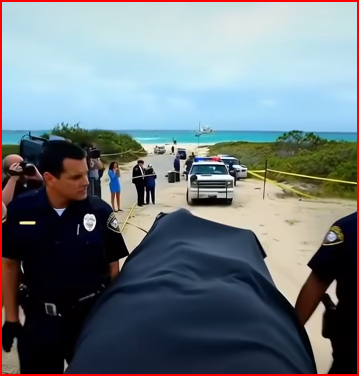For nearly twenty years, the name Natalee Holloway has remained etched in the collective consciousness of the American public—a story that embodies unanswered questions, lingering grief, and the relentless pursuit of truth. What began as an exciting senior trip to Aruba evolved into one of the most enduring and haunting missing-person cases of modern times. Behind the news headlines lay the unwavering dedication of a mother, a community grappling with shock, and a nation fixated on every shred of information surrounding Natalee’s fate.
Now, after decades of investigation, speculation, and relentless media attention, new information has emerged—bringing long-awaited clarity while also revealing a devastating reality far more tragic than many could have imagined.
A Promising Life Cut Short
Natalee Holloway, an ambitious and bright eighteen-year-old from Mountain Brook, Alabama, had her sights set on the future. In May 2005, she traveled to Aruba with her classmates for a senior graduation trip—a celebration of achievement, camaraderie, and the cusp of adulthood. The week promised laughter, discovery, and the joy of shared milestones before she embarked on college life, fully equipped with her perfect 4.0 GPA, a full scholarship, and the love and admiration of her family and friends.
The trip, however, would turn from a joyous celebration into a nightmare. On the night of May 30th, Natalee was last seen leaving a local nightclub with several young men. What began as an evening of youthful excitement quickly became the beginning of a long, painful mystery that would grip the nation and captivate media attention for years.
Aruba, a picturesque island known for its pristine beaches and welcoming culture, suddenly became the focal point of an intense investigation. Authorities, journalists, and the public all turned their eyes toward the island, hoping for answers that remained frustratingly out of reach. Conflicting statements, inconsistent testimonies, and the challenges of navigating an international investigation created a complex, often maddening puzzle.
A Mother’s Tireless Quest
Amid the chaos, one figure stood resolute: Beth Holloway, Natalee’s devoted mother. Driven by an unwavering determination to find her daughter, Beth committed herself to search efforts that spanned land and sea. She combed beaches, explored underwater caves, and advocated persistently with authorities both in the United States and Aruba. Her advocacy extended beyond the search, becoming a symbol of the power of maternal perseverance in the face of devastating uncertainty.
Beth’s struggle was not only physical but deeply emotional. The constant public attention and media scrutiny magnified her grief, yet she remained focused on the central question that haunted her day and night: Where is Natalee?
The Central Figure and the Shadow of Suspicion
From the earliest days of the investigation, suspicion quickly centered on Joran van der Sloot, a Dutch national who had been among the last individuals seen with Natalee. Though he was arrested during the initial investigation, he was subsequently released, and his inconsistent stories over the years only deepened public confusion and heartbreak.
While van der Sloot was never formally charged in Aruba, his involvement in the case became emblematic of the unresolved mystery. Each media appearance, each conflicting statement, kept Natalee’s disappearance in the spotlight, prolonging the Holloway family’s anguish and the public’s search for closure.
Beth Holloway described the enduring agony of this uncertainty:
“There’s nothing more painful than not knowing. It becomes your entire world—a constant, unbearable waiting filled with hope and fear.”
Over time, countless books, documentaries, and media analyses explored every facet of Natalee’s story. Yet, despite public fascination and investigative efforts, her fate remained a haunting enigma.
The Breakthrough: A Confession After Nearly Two Decades
Nearly twenty years after Natalee vanished, a shocking development altered the trajectory of the case. While serving a prison sentence abroad for unrelated crimes, Joran van der Sloot made a stunning confession regarding Natalee’s disappearance. This revelation sent shockwaves through the Holloway family, reigniting public attention and shedding light on a tragedy long shrouded in mystery.
In his confession, van der Sloot admitted that the events of that night were deliberate and calculated. He described in chilling detail how what seemed like a harmless evening turned fatal, and how he disposed of evidence in a manner that rendered recovery nearly impossible.
This admission, though horrifying, provided the Holloway family with the long-sought clarity they had yearned for. For Beth Holloway, the confirmation of her worst fears brought sorrow rather than relief:
“We finally have answers, but nothing can bring Natalee back.”
Despite the revelation, Natalee’s remains have never been recovered, denying her family the opportunity for a proper farewell and prolonging the mourning process. Yet, even painful truth represents a critical step toward closure.
Transforming Tragedy Into Advocacy
Natalee Holloway’s disappearance not only marked a profound personal loss for her family but also reshaped the way missing-person cases are approached worldwide. Her story prompted improvements in collaboration between U.S. and international law enforcement, as well as changes to legislation designed to protect young travelers abroad.
Beth Holloway turned her grief into purposeful action, founding the Natalee Holloway Resource Center. The organization works tirelessly to support families of missing persons and to educate travelers about personal safety, ensuring that Natalee’s legacy extends beyond tragedy into meaningful advocacy.
Lessons From an Enduring Mystery
The Holloway case is more than a story of loss—it is a cautionary tale and a testament to resilience. It reminds the public of the vulnerabilities young travelers face, the importance of vigilant law enforcement collaboration, and the enduring power of a mother’s love.
Moreover, Natalee’s story highlights the psychological and emotional toll of unresolved cases. Families of missing persons often live in a perpetual state of limbo, experiencing compounded grief as public attention waxes and wanes. For Beth Holloway, the decades-long search became a mission of hope, persistence, and unwavering advocacy.
A Legacy Beyond Tragedy
Even though Natalee’s life was tragically cut short, her story continues to resonate. Her name serves as a symbol of life’s fragility, the dangers that can lie behind seemingly ordinary circumstances, and the unbreakable bond between a parent and child.
Through Beth Holloway’s tireless efforts, Natalee’s disappearance has catalyzed systemic change, raised public awareness, and provided support for families enduring similar crises. Each memory, photograph, and call for justice reinforces the enduring influence of her story.
Natalee’s legacy, though rooted in tragedy, continues to inspire vigilance, advocacy, and compassion. Her case remains a solemn reminder of the profound impact one life can have on countless others, long after the events themselves.
Conclusion: Hope, Closure, and the Power of Truth
The Natalee Holloway case illustrates the complexity of grief, the challenges of international investigations, and the unyielding pursuit of truth. While the final outcome brings heartbreak, it also offers clarity and a framework for understanding the importance of persistence, advocacy, and systemic improvement.
Natalee’s story is a testament to the enduring power of a mother’s love and the resilience of those who refuse to give up in the face of unimaginable tragedy. Her legacy continues to shape public consciousness, inspire protective measures for young travelers, and remind the world that while life can be unexpectedly cruel, compassion and perseverance can create enduring impact.
In the end, Natalee Holloway’s name is not only a symbol of loss but a call to action—an enduring reminder that the search for justice, truth, and safety remains vital, even decades later.


